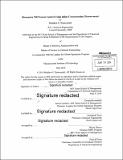| dc.contributor.advisor | Donald Rosenfield and Bernhardt Trout. | en_US |
| dc.contributor.author | Dumouchel, Matthew P. (Matthew Paul) | en_US |
| dc.contributor.other | Leaders for Global Operations Program. | en_US |
| dc.date.accessioned | 2014-10-08T15:29:58Z | |
| dc.date.available | 2014-10-08T15:29:58Z | |
| dc.date.copyright | 2014 | en_US |
| dc.date.issued | 2014 | en_US |
| dc.identifier.uri | http://hdl.handle.net/1721.1/90800 | |
| dc.description | Thesis: M.B.A., Massachusetts Institute of Technology, Sloan School of Management, 2014. In conjunction with the Leaders for Global Operations Program at MIT. | en_US |
| dc.description | Thesis: S.M., Massachusetts Institute of Technology, Department of Chemical Engineering, 2014. In conjunction with the Leaders for Global Operations Program at MIT. | en_US |
| dc.description | Cataloged from PDF version of thesis. | en_US |
| dc.description | Includes bibliographical references (pages 75-77). | en_US |
| dc.description.abstract | Some biopharmaceutical companies have responded to evolution of the competitive landscape by placing additional emphasis on reducing their costs of manufacturing as a means of maintaining competitiveness. The prototypical current generation biopharmaceutical drug substance manufacturing facility requires a large upfront capital investment. Improving efficiency of use of existing facilities, such as by improving production throughput through the adoption of technology, represents one way in which a company may reduce its costs of manufacturing and/or avoid or delay investments in additional capacity needed to meet future demand. Reducing the variability in the performance of a liquid filling operation taking place during the protein production step is desirable, because it: (1) enables process optimization, including potential throughput expansion, (2) demonstrates control over the process, and (3) improves step yield reproducibility. The technical and economic bases for the implementation of an alternative process control strategy intended to reduce this variability are presented. This strategy involves controlling the fill operation using an inline concentration measurement of the parameter of interest. An engineering-probabilistic approach, consisting of a transient concentration profile model built into a Monte Carlo framework, is applied to predict the variability of the performance of a concentration-based control strategy for filling an agitated, gassed bioreactor. An optimization methodology for selecting an appropriate post-fill target concentration and for quantifying the economic benefit of reducing variability is proposed. | en_US |
| dc.description.statementofresponsibility | by Matthew P. Dumouchel. | en_US |
| dc.format.extent | 83 pages | en_US |
| dc.language.iso | eng | en_US |
| dc.publisher | Massachusetts Institute of Technology | en_US |
| dc.rights | M.I.T. theses are protected by copyright. They may be viewed from this source for any purpose, but reproduction or distribution in any format is prohibited without written permission. See provided URL for inquiries about permission. | en_US |
| dc.rights.uri | http://dspace.mit.edu/handle/1721.1/7582 | en_US |
| dc.subject | Sloan School of Management. | en_US |
| dc.subject | Chemical Engineering. | en_US |
| dc.subject | Leaders for Global Operations Program. | en_US |
| dc.title | Bioreactor Fill Process Control Using Inline Concentration Measurement | en_US |
| dc.type | Thesis | en_US |
| dc.description.degree | M.B.A. | en_US |
| dc.description.degree | S.M. | en_US |
| dc.contributor.department | Leaders for Global Operations Program at MIT | en_US |
| dc.contributor.department | Massachusetts Institute of Technology. Department of Chemical Engineering | |
| dc.contributor.department | Sloan School of Management | |
| dc.identifier.oclc | 891583459 | en_US |
